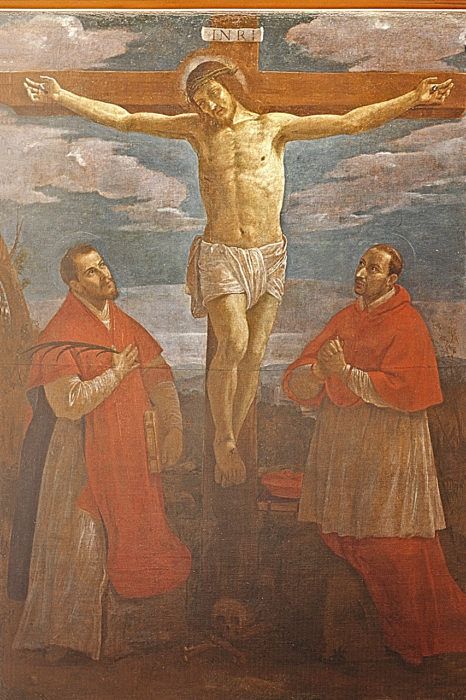Click the artworks to find out more about them
Ercole Sarti (1593–1636)
Ercole Sarti was born on 23 December 1593 in Ficarolo, a small town near Rovigo. He was born to Giovanni Sarti and Fulvia Nigrisoli and was one of the most accomplished painters in the Estense region in the first half of the seventeenth century. Ercole was the grandson of Bartolomeo Sarti, a lawyer and owner of properties in Ficarolo and Ferrara. The Sarti family was affluent and owned a collection of art comprising 92 paintings, a selection of maps and a library of 430 volumes.
Sarti is first mentioned in the Relazione della Processione Solenne fatta nella traslazione dell’Immagine Miracolosa della Beata Vergine, an account by Marcantonio Guarini detailing the procession organised in Ficarolo on 3 October 1610 on the occasion of the transportation of a miraculous image with the Adoration of the Magi from the house of the local Cavichioli family to the church of Sant’Antonino Martire. The image had attracted considerable attention since 2 June 1602, when the figure of the Virgin wept visibly. The miracle repeated itself eleven days later, on June 13. The sensation of this extraordinary phenomenon elicited visits from cardinals and princes prompting Giovanni Fontana, the bishop of Ferrara, to inform Pope Paul V. The pope not only recognised the miracle, but also conceded plenary indulgence to those willing to visit the picture upon its relocation into a newly built chapel in the church of Sant’Antonino Martire. On 3 October 1610, more than 5000 people, comprising delegations from Padua, Rovigo and Modena, paraded through the streets of Ficarolo bringing the picture to its new location. The procession moved into a large avenue decorated by Flemish tapestries and by a triumphal arch on which a painted replica of the Adoration of the Magi was on display. Guarini reports that the image had been executed “with art and precision by Ercole Sarti, a sixteen-year-old boy, mute, of great potential”. This event marks the start of his career.
Shortly after this event occurred, at the age of 18, Ercole moved to Ferrara, where his family owned a house in the San Francesco district. There he entered the workshop of Ippolito Scarsella, also known as Scarsellino (c. 1550–1620), the best painter in the city. Although it is not possible to accurately determine the exact date in which Sarti entered Scarsellino’s workshop, an autograph Holy Family copied from a painting by Raphael and recorded in the inventory of the Costabili collection indicates that in 1612 he had already embarked on his career as an artist. Ercole collaborated with Scarsellino until his master’s death in 1620. Afterwards, he started his own practice, completing public and private commissions in Ferrara and in peripheral areas of the nearby provinces of Mantua and Rovigo. In Ferrara, Sarti painted a canvas depicting Pope Sylvester (Pinacoteca Nazionale, Ferrara) for the church of San Silvestro. Completed between 1620 and 1625, the painting was noticed around the middle of the nineteenth century by Camillo Laderchi in the collection of the Costabili house and described as “painting that measures up with the best works of Scarsellino”. In Ficarolo, Sarti painted altarpieces for the church of Sant’Antonino Martire. The canvases represent the Madonna with Saints Antonino and Carlo Borromeo and the Madonna with Saints Rocco and Sebastiano (also known as the Virgin of the Plague), the latter an ex voto for the plague that struck Ferrara between 1629 and 1631. The painter’s catalogue is completed by a Crucifixion with St Valentine in the church of San Valentino in Salara, and by a Crucifixion with St Lawrence painted in the village of Quatrelle, near Mantua.
Aside from early modern biographies, Ercole Sarti’s career is celebrated by two seventeenth century poems. Giovanni Battista Marino (1569-1625) mentioned the Ferrarese painter in his famous Galeria (1620), an anthology of poems dedicated to works of art, while Francesco Berni dedicated to him an epithalamium entitled Il Tebro which celebrates the portrait that Sarti painted in 1631 on the occasion of the wedding between the Ferrarese noblewoman Beatrice Estense Tassoni and Giovanni Francesco Sacchetti. In describing Sarti’s portrait, Berni writes muto pittor colour loquace (mute painter spreads talking colours), following a premise of Renaissance art theory that identifies silence as an attribute of painting. Exemplified by Salvator Rosa’s Philosophy (National Gallery, London), the trope of painting as silent poetry/mute eloquence was justified through Horace’s ut pictura poesis and had been already recognised by Leonardo da Vinci who observed: “painting is a mute poem, poetry is blind painting”. Sarti died in 1636 and was buried in the church of Santo Spirito in Ferrara.
Bibliography
Lo Conte, Angelo. ‘Talking colours: Ercole Sarti and the verses that gave voice to his paintings’. Source: Notes in the History of Art, vol. 42 (4), 2022.
Ghelfi, Barbara. Pittura a Ferrara nel primo Seicento: arte committenza e spiritualità. Ferrara, 2011, 227-228.
Novelli, Maria Angela. ‘Un pittore ferrarese nella Galeria di Giambattista Marino’. In L’aquila bianca: studi di storia estense per Luciano Chiappini, Antonio Samaritani and Ranieri Varese (eds.), Ferrara, 2000, 505-519.
De Pisis, Filippo. Ercole Sarti detto il muto da Ficarolo. Ferrara, 1915.
Laderchi, Camillo. La pittura ferrarese: memorie del conte Camillo Laderchi. Ferrara, 1856.
Cittadella, Cesare. Catalogo istorico de pittori e scultori ferraresi e delle opere loro. Ferrara, 1783.
Berni, Francesco. Il torneo a piedi: e l’invenzione, ed allegoria, colla quale il Signor Benso Bonaccorsi comparì a mantenerlo. Ferrara, 1631.
Marino, Giovanni Battista. La Galeria, La Galeria del cavalier Marino. Venice, 1620.
Guarini, Marcantonio. Relatione della processione solenne fatta nella traslazione dell’Immagine della Beata Vergine posta nella Chiesa Collegiata della Terra di Figarolo, descritta da Marc’Antonio Guarini. Ferrara, 1611.


